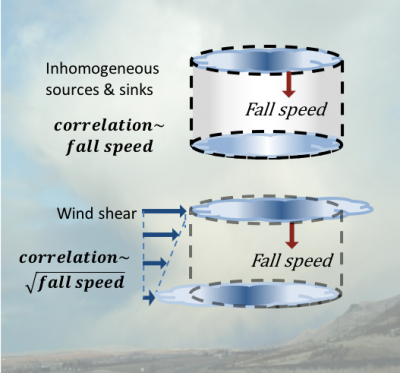Level by level: Constructing the Vertical Structure of Clouds
The vertical structure of clouds is a critical factor in precipitation formation and heat transfer in the atmosphere. In climate models, however, grid spacing remains too large to resolve individual clouds, so cloud properties at various altitudes are represented through statistical distributions. To recover profiles of cloud properties that vary horizontally, such as cloud and precipitation mass content or droplet number concentration, their distributions must be aligned vertically using assumptions about a cloud’s vertical structure. So far, these assumptions have been arbitrary and inconsistent among different model components. Researchers at the U.S. Department of Energy (DOE) led a study linking the degree of vertical alignment of cloud and precipitation properties to their fall speeds. These results provided a physical basis for a new representation to improve the treatment of unresolved cloud variability.
By linking the vertical alignment of subgrid-scale cloud and precipitation characteristics to a real physical quantity predicted by the model—i.e., fall speed—this study will lead to improved distributions of cloud properties in climate simulations. The new approach to improve the treatment of unresolved cloud variability will ensure consistent representations of cloud profiles among different components of DOE’s Energy Exascale Earth System Model (E3SM).
In large‐scale weather prediction and climate models, the vertical structure of clouds is represented in terms of overlapping statistical distributions of various water types in the atmosphere. A previous study found that fast-falling cloud particles, or hydrometeors, were more likely to line up vertically and could be represented in models statistically. Non-precipitating clouds have significantly larger variability layer by layer and, therefore, a more random overlap. These phenomena are important to represent in the model to get the best depiction of the cloud. The study suggested that to improve the representation of cloud overlap, the correlations between cloud particles at different levels had to depend on particle properties, such as fall speeds, in addition to an existing dependency on convection strength.
Building on that work, researchers showed that the vertical correlation varied widely for different hydrometeor types, such as cloud liquid and ice, rain, snow, and graupel (soft hail). Results indicated corresponding fall speed as the primary factor controlling the degree of vertical alignment of these hydrometeor types, with vertical shear of the horizontal wind playing a smaller role. Researchers derived relationships between vertical correlation and fall speed by analyzing high-resolution simulations of cloud systems over DOE Atmospheric Radiation Measurement (ARM) user facility sites in Oklahoma and Australia, as well as radar observations. Further examinations using simple conceptual models linked horizontal and vertical cloud variability and provided insights into the roles of corresponding fall speed and wind shear. From this analysis, researchers proposed a parameterization that captured the observed range of vertical correlations. When based on a physical property of hydrometeors, such as fall speed, rather than artificially defined and model‐specific hydrometeor types, the parameterization can be applied to a wide range of treatments for microphysics, radiation, and instrument simulator calculations. This, in turn, will lead to improved regional and global models.

